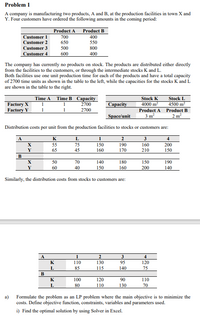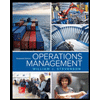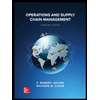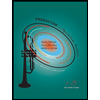
Practical Management Science
6th Edition
ISBN: 9781337406659
Author: WINSTON, Wayne L.
Publisher: Cengage,
expand_more
expand_more
format_list_bulleted
Question

Transcribed Image Text:Problem 1
A company is manufacturing two products, A and B, at the production facilities in town X and
Y. Four customers have ordered the following amounts in the coming period:
Product A Product B
Customer 1
Customer 2
700
400
650
550
Customer 3
500
800
Customer 4
600
400
The company has currently no products on stock. The products are distributed either directly
from the facilities to the customers, or through the intermediate stocks K and L.
Both facilities use one unit production time for each of the products and have a total capacity
of 2700 time units as shown in the table to the left, while the capacities for the stocks K and L
are shown in the table to the right.
Time A
Time B Cараcity
Stock K
Stock L
4500 m²
Factory X
Factory Y
2700
Сараeity
4000 m2
2700
Product A
Product B
Space/unit
3 m2
2 m?
Distribution costs per unit from the production facilities to stocks or customers are:
K
L
1
2
3
X
55
75
150
190
160
200
Y
65
45
160
170
210
150
B
50
70
140
180
150
190
60
40
150
160
200
140
Similarly, the distribution costs from stocks
customers are:
A
1
2
3
4
K
110
130
95
120
L
85
115
140
75
В
K
100
120
90
110
80
110
130
70
a)
Formulate the problem as an LP problem where the main objective is to minimize the
costs. Define objective function, constraints, variables and parameters used.
i) Find the optimal solution by using Solver in Excel.
Expert Solution
This question has been solved!
Explore an expertly crafted, step-by-step solution for a thorough understanding of key concepts.
This is a popular solution
Trending nowThis is a popular solution!
Step by stepSolved in 2 steps with 4 images

Knowledge Booster
Similar questions
- The distribution of daily demand for rental trucks at a vehicle rental company is shown in the following table: Relative Frequency Demand 0.07 0 0.14 1 0.15 2 0.14 3 0.12 4 0.08 5 0.3 6 Trucks are rented by the day only and the company makes $14 per rented truck per day. The rental company keeps four trucks at this location. Assuming that the stocking decision is optimal, what is the implied range of excess cost per truck per day? a. 0 and 186 b. 8.58064 and 14 c. 14 and 24.8889 d. 6 and 8.58064 e. 34.2759 and 79.3333arrow_forward1 ton of material 1 ton of material 2, and 11/13 3 10 The Kashif Corporation blends three raw materials to produce two products: a fuel additive and a solvent base. Each ton of fuel additive is a mixture of ton of material 1 and 3 ton of material 3. A ton of solvent base is a mixture of // Kashif's production is constrained by a limited availability of the three raw materials. For the current production period, Kashif has the following quantities of each raw material: material 1, 20 tons; material 2, 5 tons; material 3, 21 tons. Management wants to achieve the following P, priority level goals. Goal 1: Produce at least 30 tons of fuel additive. Goal 2: Produce at least 15 tons of solvent base. Assume there are no other goals. (a) Is it possible for management to achieve both P₁ level goals given the constraints on the amounts of each material available? If not, which constraint is the limiting factor? O Yes. It is possible to satisfy both P₁ level goals. O No. There is an insufficient…arrow_forwardQ: The Morton Supply Company produces clothing, footwear, and accessories for dancing and gymnastics. They produce three models of pointe shoes used by ballerinas to balance on the tips of their toes. The shoes are produced from four materials: cardstock, satin, plain fabric, and leather. The number of square inches of each type of material used in each model of shoe, the amount of material available, and the profit/model are shown below: Material (measured in square inches) Model 1 Model 2 Model 3 Material Available Cardstock 12 10 14 1200 Satin 24 20 15 2000 Plain fabric 40 40 30 7500 Leather 11 11 10 1000 Profit per model $50 $44 $40 a) Generate the Sensitivity Report in EXCEL for the model that you built. Interpret, in context, the Shadow Price for the Leather and the Satin constraints. Include units in your interpretations.arrow_forward
- Susan manages the packaging supplies for the New Zealand distributorship of AllBirds product lines. It;s her job to order all the shoe boxes that house each pair of shoes (whether going to retail stores, or shipping directly to consumers via the online store). She purchases shoe boxes from a local printing supplier. The NZ distributor ships on average 325 boxes of shoes each month. Boxes cost $2.25 each, and each order costs $18 to process. Because of limited storage space, Susan's manager wants to charge inventory holding at 25% of the unit cost. The lead time is 7 days. Assume 360 working days per year. Calculate the following: a. Economic order Wuantity b. Reorder Point (assuming no safety stocks) c.Number of orders-per-Year d.Total annual cost e.If storage space was so limited, Susan estimates that inventory holding cots would only be 15% of unit cost. How would that change total annual costs?arrow_forward14. Toyco produces a line of Bonnie dolls and accessories at its plants in New York and Baltimore that must be shipped to distribution centers in Chicago and Los Angeles. The company uses Air Freight, Inc., to make its shipments. Suppose that it can ship directly or through Pittsburgh and Denver. The daily production rates at the plants are respectively 5,000 and 7,000 units daily, and the demands at the dis- tribution centers are respectively 3,500 and 8,500 units daily. The costs of shipping 1,000 units are given in the following table. Find the optimal shipping routes and the associated cost. то Pittsburgh Denver Chicago Los Angeles New York Baltimore F $182 $375 $285 $460 R 77 290 245 575 Pittsburgh 275 125 380 M Denver 90 110 -arrow_forward
arrow_back_ios
arrow_forward_ios
Recommended textbooks for you
 Practical Management ScienceOperations ManagementISBN:9781337406659Author:WINSTON, Wayne L.Publisher:Cengage,
Practical Management ScienceOperations ManagementISBN:9781337406659Author:WINSTON, Wayne L.Publisher:Cengage, Operations ManagementOperations ManagementISBN:9781259667473Author:William J StevensonPublisher:McGraw-Hill Education
Operations ManagementOperations ManagementISBN:9781259667473Author:William J StevensonPublisher:McGraw-Hill Education Operations and Supply Chain Management (Mcgraw-hi...Operations ManagementISBN:9781259666100Author:F. Robert Jacobs, Richard B ChasePublisher:McGraw-Hill Education
Operations and Supply Chain Management (Mcgraw-hi...Operations ManagementISBN:9781259666100Author:F. Robert Jacobs, Richard B ChasePublisher:McGraw-Hill Education
 Purchasing and Supply Chain ManagementOperations ManagementISBN:9781285869681Author:Robert M. Monczka, Robert B. Handfield, Larry C. Giunipero, James L. PattersonPublisher:Cengage Learning
Purchasing and Supply Chain ManagementOperations ManagementISBN:9781285869681Author:Robert M. Monczka, Robert B. Handfield, Larry C. Giunipero, James L. PattersonPublisher:Cengage Learning Production and Operations Analysis, Seventh Editi...Operations ManagementISBN:9781478623069Author:Steven Nahmias, Tava Lennon OlsenPublisher:Waveland Press, Inc.
Production and Operations Analysis, Seventh Editi...Operations ManagementISBN:9781478623069Author:Steven Nahmias, Tava Lennon OlsenPublisher:Waveland Press, Inc.

Practical Management Science
Operations Management
ISBN:9781337406659
Author:WINSTON, Wayne L.
Publisher:Cengage,

Operations Management
Operations Management
ISBN:9781259667473
Author:William J Stevenson
Publisher:McGraw-Hill Education

Operations and Supply Chain Management (Mcgraw-hi...
Operations Management
ISBN:9781259666100
Author:F. Robert Jacobs, Richard B Chase
Publisher:McGraw-Hill Education


Purchasing and Supply Chain Management
Operations Management
ISBN:9781285869681
Author:Robert M. Monczka, Robert B. Handfield, Larry C. Giunipero, James L. Patterson
Publisher:Cengage Learning

Production and Operations Analysis, Seventh Editi...
Operations Management
ISBN:9781478623069
Author:Steven Nahmias, Tava Lennon Olsen
Publisher:Waveland Press, Inc.